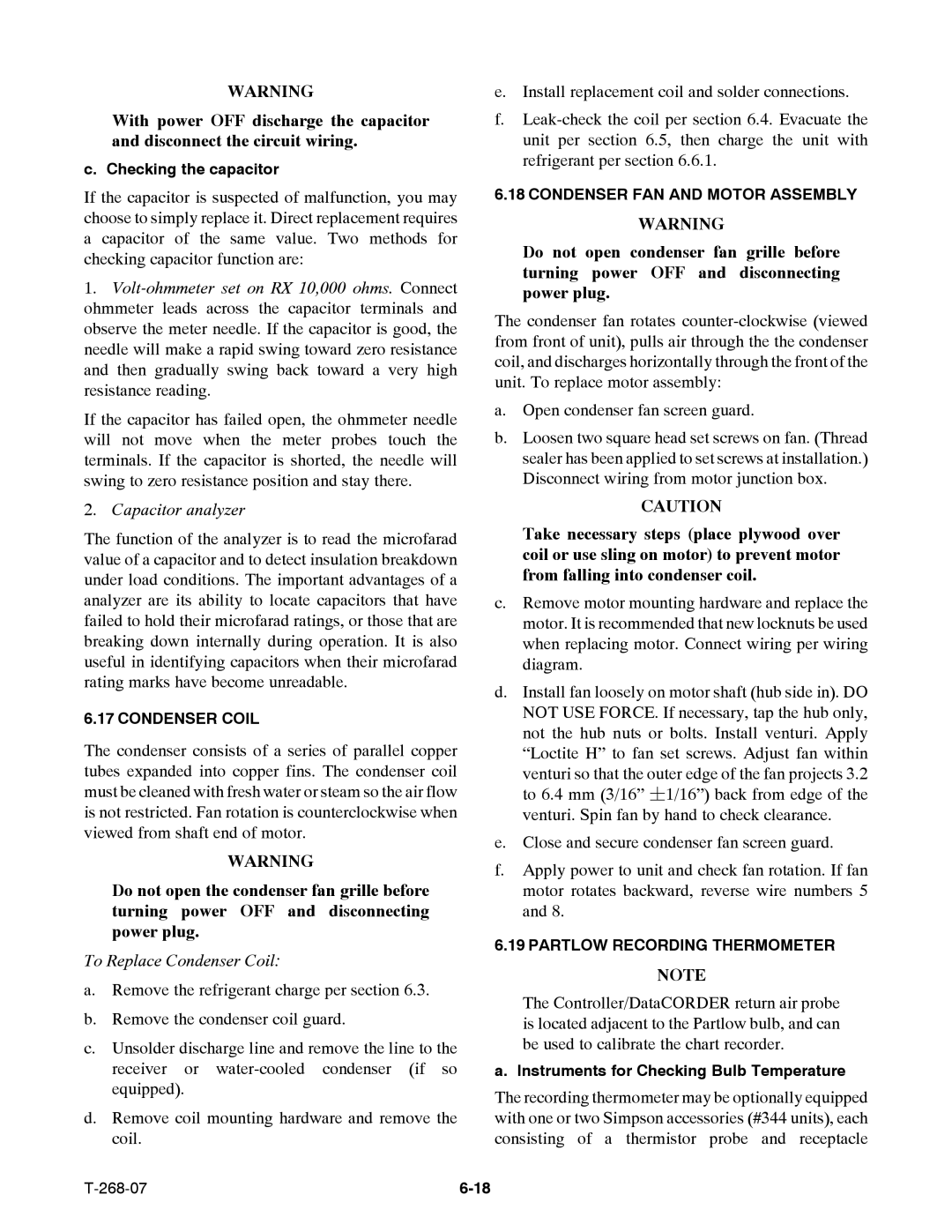WARNING
With power OFF discharge the capacitor and disconnect the circuit wiring.
c. Checking the capacitor
If the capacitor is suspected of malfunction, you may choose to simply replace it. Direct replacement requires a capacitor of the same value. Two methods for checking capacitor function are:
1.
If the capacitor has failed open, the ohmmeter needle will not move when the meter probes touch the terminals. If the capacitor is shorted, the needle will swing to zero resistance position and stay there.
2.Capacitor analyzer
The function of the analyzer is to read the microfarad value of a capacitor and to detect insulation breakdown under load conditions. The important advantages of a analyzer are its ability to locate capacitors that have failed to hold their microfarad ratings, or those that are breaking down internally during operation. It is also useful in identifying capacitors when their microfarad rating marks have become unreadable.
6.17 CONDENSER COIL
The condenser consists of a series of parallel copper tubes expanded into copper fins. The condenser coil must be cleaned with fresh water or steam so the air flow is not restricted. Fan rotation is counterclockwise when viewed from shaft end of motor.
WARNING
Do not open the condenser fan grille before turning power OFF and disconnecting power plug.
To Replace Condenser Coil:
a.Remove the refrigerant charge per section 6.3.
b.Remove the condenser coil guard.
c.Unsolder discharge line and remove the line to the receiver or
d.Remove coil mounting hardware and remove the coil.
e.Install replacement coil and solder connections.
f.
6.18 CONDENSER FAN AND MOTOR ASSEMBLY
WARNING
Do not open condenser fan grille before turning power OFF and disconnecting power plug.
The condenser fan rotates
a.Open condenser fan screen guard.
b.Loosen two square head set screws on fan. (Thread sealer has been applied to set screws at installation.) Disconnect wiring from motor junction box.
CAUTION
Take necessary steps (place plywood over coil or use sling on motor) to prevent motor from falling into condenser coil.
c.Remove motor mounting hardware and replace the motor. It is recommended that new locknuts be used when replacing motor. Connect wiring per wiring diagram.
d.Install fan loosely on motor shaft (hub side in). DO NOT USE FORCE. If necessary, tap the hub only, not the hub nuts or bolts. Install venturi. Apply “Loctite H” to fan set screws. Adjust fan within venturi so that the outer edge of the fan projects 3.2 to 6.4 mm (3/16” ¦1/16”) back from edge of the venturi. Spin fan by hand to check clearance.
e.Close and secure condenser fan screen guard.
f.Apply power to unit and check fan rotation. If fan motor rotates backward, reverse wire numbers 5 and 8.
6.19 PARTLOW RECORDING THERMOMETER
NOTE
The Controller/DataCORDER return air probe is located adjacent to the Partlow bulb, and can be used to calibrate the chart recorder.
a. Instruments for Checking Bulb Temperature
The recording thermometer may be optionally equipped with one or two Simpson accessories (#344 units), each consisting of a thermistor probe and receptacle
|
